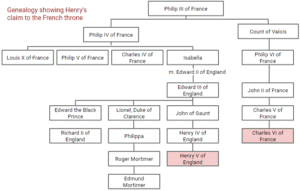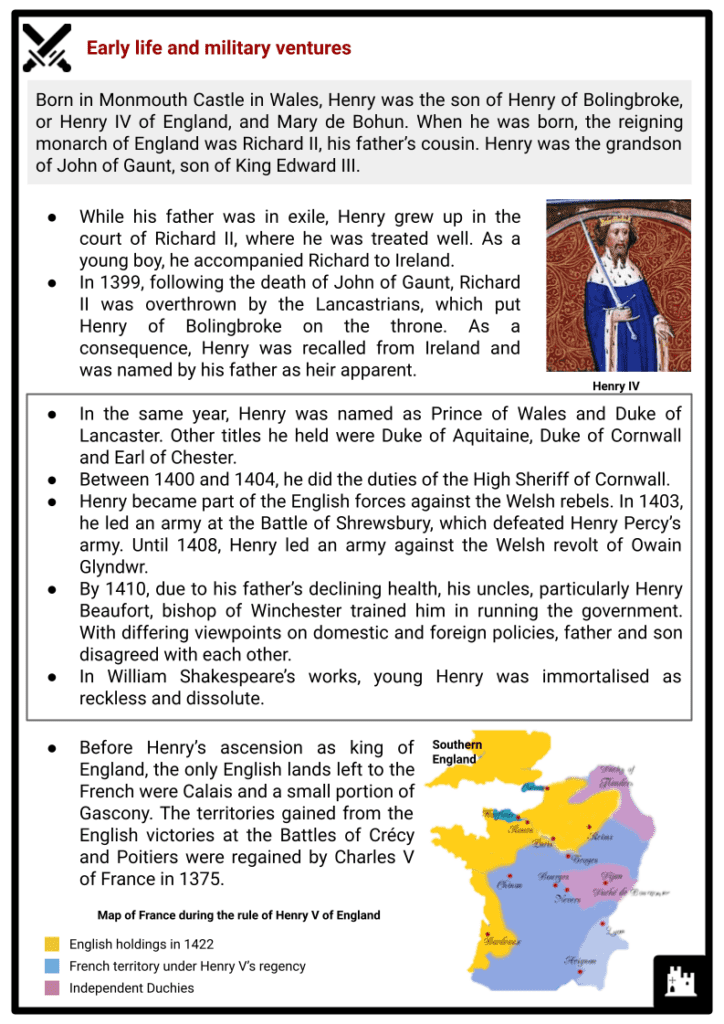Download Henry V of England
Do you want to save dozens of hours in time? Get your evenings and weekends back? Be able to teach about Henry V of England to your students?
Our worksheet bundle includes a fact file and printable worksheets and student activities. Perfect for both the classroom and homeschooling!
Table of Contents
Add a header to begin generating the table of contents
Summary
- Early life and military ventures
- Henry V as king of England: Domestic Affairs
- Henry V as king of England: War with France
Key Facts And Information
Let’s find out more about Henry V of England!

- Henry V, or Henry Monmouth, was the king of England between 1413 and 1422. Despite his relatively short reign, Henry V was regarded as one of the greatest warrior kings of England. He was known for the English military successes against the French in the Hundred Years’ War. Moreover, his reign saw England’s control of Normandy. One of his most famous victories was at the Battle of Agincourt in 1415, leading to Troyes’ Treaty with the French king Charles VI. At 35, Henry was weakened by dysentery and died in 1422, possibly of heatstroke.
- During Henry V’s reign, England and France were on the verge of a political union. Henry married Charles VI’s daughter, Catherine of Valois. Moreover, the Treaty of Troyes recognised Henry as heir apparent to the French throne and regent. However, two years after the agreement, Henry died and left the infant Henry VI on the throne.
Early life and military ventures
Born in Monmouth Castle in Wales, Henry was the son of Henry of Bolingbroke, or Henry IV of England, and Mary de Bohun. When he was born, the reigning monarch of England was Richard II, his father’s cousin. Henry was the grandson of John of Gaunt, son of King Edward III.
- While his father was in exile, Henry grew up in the court of Richard II, where he was treated well. As a young boy, he accompanied Richard to Ireland.
- In 1399, following the death of John of Gaunt, Richard II was overthrown by the Lancastrians, which put Henry of Bolingbroke on the throne. As a consequence, Henry was recalled from Ireland and was named by his father as heir apparent.
- In the same year, Henry was named as Prince of Wales and Duke of Lancaster. Other titles he held were Duke of Aquitaine, Duke of Cornwall and Earl of Chester.
- Between 1400 and 1404, he did the duties of the High Sheriff of Cornwall.
- Henry became part of the English forces against the Welsh rebels. In 1403, he led an army at the Battle of Shrewsbury, which defeated Henry Percy’s army. Until 1408, Henry led an army against the Welsh revolt of Owain Glyndwr.
- By 1410, due to his father’s declining health, his uncles, particularly Henry Beaufort, bishop of Winchester trained him in running the government. With differing viewpoints on domestic and foreign policies, father and son disagreed with each other.
- In William Shakespeare’s works, young Henry was immortalised as reckless and dissolute.
- Before Henry’s ascension as king of England, the only English lands left to the French were Calais and a small portion of Gascony. The territories gained from the English victories at the Battles of Crécy and Poitiers were regained by Charles V of France in 1375.
Henry V as king of England: Domestic Affairs
- On 20 March 1413, Henry IV died. Henry V was crowned on 9 April 1413 at Westminster Abbey. His reign was initially threatened by uprisings and conspiracies, notably plotted by Richard of York in favour of Edmund Mortimer, 5th Earl of March. Despite his association with a number of revolts, Mortimer remained loyal to King Henry V.
- In August 1417, Henry ordered the use of the English government in transactions and records. Since the Norman Conquest, Henry was the first king of England to use the English language in his personal correspondence.
- Domestically, Henry’s rule was generally peaceful. He was able to subdue any insurrections before they became serious.
- The Southampton Plot revealed in 1415 was a conspiracy to overthrow Henry V in favour of Edmund Mortimer. The plot was planned by Richard of Conisburgh (Mortimer’s brother-in-law), Henry Scrope and Sir Thomas Grey.
- Mortimer’s faction argued that the Earl of March had a superior claim to the throne of England than Henry V. Mortimer was the great-grandson of Lionel of Antwerp, second son of King Edward III. Meanwhile, John of Gaunt, Henry’s patrilineal descent, was the third son of Edward III. Moreover, Mortimer’s father, Roger, was named heir presumptive to Richard II.
- On 30 July 1415, Mortimer informed Henry about the plot. As an immediate consequence, the three ringleaders of the plot were arrested and beheaded.
Henry V as king of England: War with France
- With Henry V’s determination to regain the lost lands of England, he sailed to France in August 1415. By September, Henry’s forces besieged Harfleur in Normandy. Despite the warnings of his council, Henry and his army marched towards Calais.
- On 25 October, Henry’s exhausted and outnumbered troops managed to defeat the intercepting French army near Agincourt. Historians suggest that the French men-at-arms were stuck in the muddy battlefield, which hindered their advance and made them openly vulnerable to English and Welsh archers.

- The Battle of Agincourt was considered one of the greatest English victories during the Hundred Years’ War. Others were the Battle of Crécy in 1346 and the Battle of Poitiers in 1356.
- At the time of the battle, the French army was commanded by Constable Charles d’Albret, and not Charles VI of France, who was then suffering from mental illness.
- Meanwhile, about 80% of the English army were longbow archers. In 1599, the battle was used by Shakespeare in his play entitled Henry V.
- For the French, the aftermath of the Battle of Agincourt was devastating. Aside from around 6,000 men on foot, more than a hundred lords, three dukes, a viscount, a constable, an admiral and an archbishop were killed. Those who were held prisoner were executed.
- Despite the decisive victory at Agincourt, Henry decided not to further the English conquest. Instead, he led his army back to London in November. Henry’s victory made him more popular in England. The victory also sealed the legitimacy of the Lancastrian monarchy.
- In 1417, Henry renewed the war with France. He successfully conquered Caen, Lower Normandy and Rouen. After six months of negotiation, Henry was recognised as regent of France under the Treaty of Troyes.
- On 2 June 1420, the Anglo-French union was further strengthened through the marriage of Henry V and Catherine of Valois at Troyes Cathedral. Between June and July 1420, Henry took the French military fortresses near Paris. By November, Melun in north-central France was captured.
- In early 1421, Henry returned to England and left his forces in France to Thomas, Duke of Clarence. In March, Thomas’ army faced a decisive defeat against a Franco-Scottish army at the Battle of Baugé. In response, Henry sailed back to France and made his last military campaign.

- As detailed in the first scenes of Shakespeare’s Henry V, the Terram Salicam Mulieres Ne Succedant meant that no one could claim the French throne through a female line (through Isabella of France in the case of Henry V). The Salic law prohibited Isabella and her line from claiming the French throne on the death of Charles IV of France, thus passing the crown to the line of the Count of Valois.
- In the play, the archbishop argued that the Salic law only applies to a German area that was once colonised by the French and not to France per se. Following the genealogy, Edward III could claim the French throne through his mother. However, Henry V still had no right to claim the throne since it was clear that Edmund Mortimer could be the king of England and France through Philippa, his grandmother. At the end of the scene, the archbishop said ‘no’ to Henry V.






